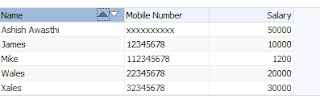This post is about creating named bind variable in viewObject at run time and filter viewObject using this bind variable in WHERE Clause of ViewObject programmatically .
Defining WHERE Clause and Bind Variable name and default value -
Setting value of Bind Variable-
Getting value of Bind Variable-
Removing WHERE Clause and Bind Variable after use-
Cheers :) Happy Learning
Defining WHERE Clause and Bind Variable name and default value -
//Get ViewObject ViewObject vo = iter.getDepartments(); //Apply desired WHERE Clause and declare bind variable name vo.setWhereClause("DEPARTMENT_NAME=:BindDepartmentName"); //Define this variable as ViewObject Bind Variable , You can also set default value for this vo.defineNamedWhereClauseParam("BindDepartmentName", "Purchase", null); // Execute ViewObject to finally apply where clause vo.executeQuery();
Setting value of Bind Variable-
//Setting Value of Bind Variable vo.setNamedWhereClauseParam("BindDepartmentName", "Finance"); vo.executeQuery();
Getting value of Bind Variable-
//Get value of Bind Variable vo.getNamedWhereClauseParam("BindDepartmentName");
Removing WHERE Clause and Bind Variable after use-
//Remove where clause vo.setWhereClause(null); //Remove Bind Variable vo.removeNamedWhereClauseParam("BindDepartmentName"); vo.executeQuery();
Cheers :) Happy Learning





















